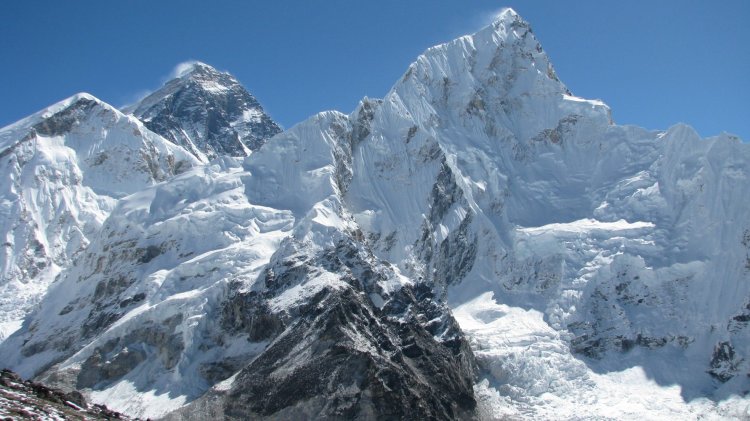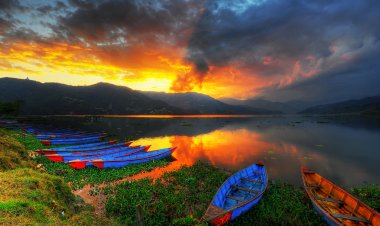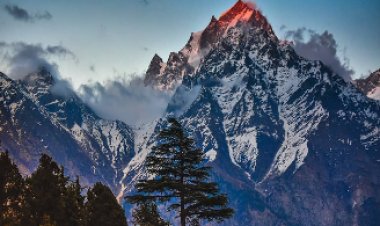Mount Lhotse: Climbing Achievements & Challenges
Explore the world of mountaineering on Mount Lhotse, the fourth-highest mountain globally, with a rich history of climbing achievements. Learn about recent milestones, unique features, and climbing routes.

Mount Lhotse, known as "South Peak" in Tibetan, is the fourth-highest mountain in the world, standing at an elevation of 8,516 meters (27,940 feet). This imposing peak is located on the border between the Tibet Autonomous Region of China and the Khumbu region of Nepal, in the Himalayan mountain range. Lhotse is renowned for its challenging climbing routes, unique features, and its close proximity to Mount Everest.
Geography and Features
Mount Lhotse, the fourth-highest mountain globally, is situated on the border between the Tibet Autonomous Region of China and the Khumbu region of Nepal, within the expansive Himalayan mountain range. Its geography and prominent features are significant in the context of its appeal to mountaineers and its relation to Mount Everest:
-
Elevation:
Mount Lhotse rises to an imposing height of 8,516 meters (27,940 feet) above sea level, making it one of the world's highest peaks. -
Location:
Lhotse is geographically positioned just south of Mount Everest, its more famous neighbor. These two mountains are connected by a ridge at an elevation of approximately 25,000 feet (7,600 meters), emphasizing their close proximity and geological connection. -
Relation to Everest:
The mountain forms an integral part of the Everest massif, and its geographical relationship with Everest is remarkable. This close connection is highlighted by the name "Lhotse", which means "South Peak" in Tibetan, underlining its position relative to Everest. -
Summits:
Lhotse features three main summits, with Lhotse Main being the highest at 8,516 meters. The other summits are Lhotse Middle and Lhotse Shar, standing at 8,414 meters and 8,383 meters, respectively. -
Challenging Terrain:
The mountain's unique geographical characteristics and challenging terrain contribute to its allure for mountaineers. The Lhotse Face, the Lhotse Couloir, and the south face offer climbers formidable and treacherous routes, making Lhotse a formidable high-altitude challenge.
Lhotse's geographical location, distinct features, and close association with Mount Everest combine to create a compelling destination for mountaineers seeking to test their skills and conquer one of the world's highest peaks.
Climbing History
Lhotse's history of exploration and climbing is rich and filled with significant milestones. In 1955, the International Himalayan Expedition, led by Norman Dyhrenfurth and comprising climbers from various countries, made an early attempt to conquer the mountain. This expedition included climbers from the United States, Austria, Switzerland, and local porters. Though they didn't reach the summit, they explored the challenging terrain and gathered valuable information.
The first successful ascent of the main summit of Lhotse took place on May 18, 1956, when the Swiss duo of Fritz Luchsinger and Ernst Reiss achieved this remarkable feat. This historic achievement marked a significant milestone in the world of mountaineering.
Over the years, Lhotse continued to attract climbers from around the world. Notable ascents include the first ascent of Lhotse Shar in 1970 by an Austrian expedition led by Sepp Mayerl and Rolf Walter. In 1979, Andrzej Czok and Jerzy Kukuczka successfully reached the main summit without the use of supplemental oxygen.
Lhotse Middle remained one of the highest unclimbed named points on Earth until May 23, 2001, when a Russian expedition made the first ascent.
Climbing Routes
Climbing Lhotse presents a formidable challenge due to its steep and treacherous terrain, extreme altitudes, and unpredictable weather conditions. The standard climbing route for Lhotse follows a similar path to that of Mount Everest up to the Yellow Band beyond Camp 3. After this point, the routes diverge, with climbers bound for Everest taking a left towards the South Col. Lhotse climbers take a different path further up the Lhotse face, navigating the narrow "Reiss couloir" until they reach the main summit.
The mountain's west face features the massive Lhotse Couloir, a treacherous ice gully that poses one of the most challenging sections of the climb, with some parts having inclines as steep as 80 degrees. Climbers must also be cautious of periodic snowfall.
Lhotse's south face is known for its tremendous vertical relief and is considered one of the steepest faces of its size in the world. Climbers attempting the south face face significant difficulties and dangers.
Climbing Records and Notable Ascents
Throughout the years, climbers from different nations have left their mark on Lhotse's history. In 1999, Czech climber Sona Vomackova reached the main summit without supplemental oxygen, becoming the first woman to achieve this feat.
In 1996, Anatoli Boukreev achieved a solo ascent with a world speed record of 21 hours and 16 minutes from Base Camp to summit, and he had previously summited Mount Everest just a week before.
Reinhold Messner became the first person to climb all of the fourteen eight-thousanders in 1986, ascending Lhotse as part of this incredible achievement.
Recent Climbing Milestones
In recent times, several notable climbing achievements on Mount Lhotse have made history. For instance, in 2018, Mexican climber Jose Luis Sanchez Fernández became the first Latin American to summit both Mount Everest and Lhotse within less than 24 hours, showcasing incredible mountaineering prowess. Additionally, Hilaree Nelson and Jim Morrison's ski descent from Lhotse's summit in 2018 marked a remarkable feat in extreme skiing, adding a new dimension to the mountain's legacy. These achievements highlight the ongoing pursuit of mountaineering excellence on this challenging Himalayan peak.
Royalty Fees
For climbers, it's essential to be aware of the royalty fees for ascending Lhotse. These fees vary depending on the season and the climber's nationality.
For Nepalese climbers, the fees are in Nepalese Rupees (NRs):
- Summer and Winter: NRs. 2,500
- Autumn and other seasons: NRs. 5,000
- Spring: NRs. 10,000
Foreign climbers are charged in United States Dollars (USD):
- Summer and Winter: $450.00
- Autumn: $900.00
- Spring: $1,800.00
These fees help support the management and preservation of the mountain and the surrounding environment. Climbers should always check with the relevant authorities or agencies for the most up-to-date information and any additional permit requirements.
Conclusion
Mount Lhotse, standing proudly as the fourth-highest mountain in the world, offers mountaineers an exhilarating and challenging experience. Its formidable terrain, the historical significance of its ascents, and its close association with Mount Everest make it a compelling destination for climbers from around the globe. With its unique climbing routes, rich history, and the thrill of conquering one of the world's tallest peaks, Lhotse continues to be a beacon for adventurers seeking to test their limits in the realm of high-altitude mountaineering.
What's Your Reaction?




































































































